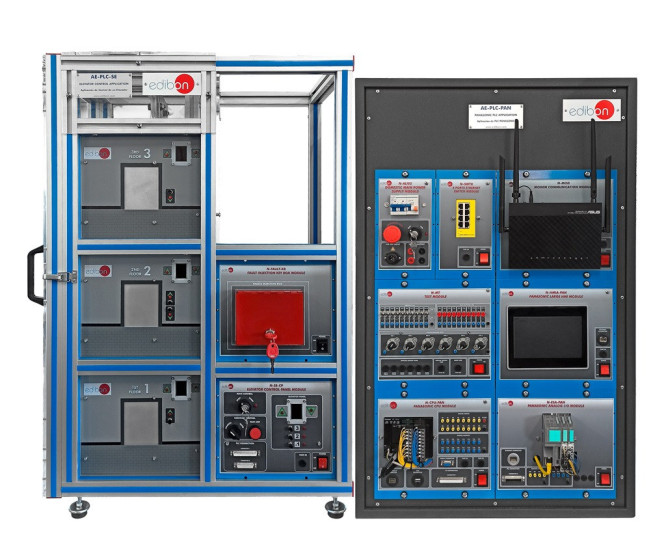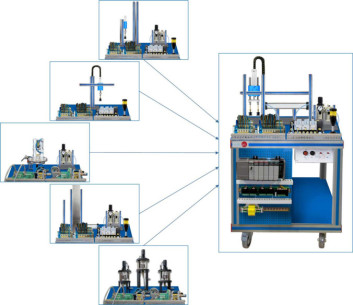The Elevator Control Application, "AE-PLC-SE", has been designed by EDIBON with a double objective. On the one hand, this application allows to study the main electro-mechanical components that nowadays integrate any elevator. The most relevant are the position sensors, electric motors to move the elevator and the sliding door, limit switches, counterweight, digital floor identifiers, call buttons, among many other mechanisms. On the other hand, all these sensors and actuators mentioned above require a programmable logic controller (PLC) that allows us to control the elevator in an efficient and safe way. Programming a PLC to control an elevator is a great challenge for any vocational or engineering student seeking to strengthen their knowledge in the field of industrial automation. That is why the "AE-PLC-SE" application is an extremely useful learning tool for PLC automation.
The "AE-PLC-SE" is an elevator built to scale that can be fully automated. It includes an aluminum structure that forms the skeleton of the elevator subdivided into three levels or floors. Inside the structure there is a vertical rail or guide by which the elevator slides between the three floors. This rail has a DC motor at the top, to whose axis is coupled a conveyor chain that transforms the rotary motion of the motor into a linear motion. This allows the linear displacement of the elevator to be controlled at all times. Each floor of the structure has call buttons as well as indicators of the current position of the car. In addition, it includes a control panel that represents the interior of the elevator car. From this panel two operating modes can be selected (automatic or manual) as well as sending the elevator to the different floors by means of three push-buttons that represent the controls inside the elevator. It also includes a fault injection module that allows to inject faults in a controlled way in the equipment with the objective of learning to identify the most frequent problems that can occur in the elevator mechanisms / signals.
The elevator car includes three aluminum plate (upper, middle and lower level) that allow to precisely locate its position. For this purpose, each floor has a capacitive sensor capable of detecting these plate. In this way, floor approach functions can be programmed, with acceleration and deceleration ramps that will allow smooth control of the car's motor response once the desired floor is reached. In the event that the elevator is not detected by any sensor because, for example, it has stopped between two floors and therefore the exact position is not known, it is possible to program an automatic alignment function that places the elevator in a reference position. Two limit switch sensors at both ends of the rail are also included as additional protection to stop the motor.
The elevator door is controlled by a DC motor and two limit switch sensors. These sensors detect when the door is fully open or fully closed. In this way, the control of the motor that drives the movement of the door can be programmed. In addition, inside the car there is a barrier sensor that can detect the interposition of an object during the closing of the door, as occurs in real elevator doors.
This application offers multiple possibilities when programming the conditions that will control the operation of the elevator. It is here where the criteria and skills of each programmer will determine these conditions although, to facilitate the understanding of the programming of this system, EDIBON offers a series of programs that can be used as examples.
 쿠키 기본 설정
쿠키 기본 설정







